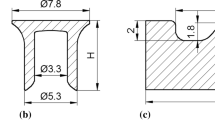Abstract
In this paper, the influence of the two main parameters of end distance and edge distance on high strength aluminum alloy ring groove rivet node failure mode, load–displacement curve and other mechanical property are studied. Many FEMs (finate element model) are established by ABAQUS software for comparative analysis under different parameters. The FEM analysis results showed that the high-strength aluminum alloy ring-groove rivet connection is the pressure-bearing connection. Compared with the bolt connection, the high-strength aluminum alloy ring-groove rivet connection has good ductility, and the yield platform of the load–displacement curve is longer. The failure forms of high-strength aluminum alloy ring-groove rivet connection mainly include rivet shear failure, plate cross-section tearing and longitudinal section tearing failure. In order to avoid the above-mentioned damage, the recommended value of the edge distance is 2d0, and the end distance is recommended to take the value 2.5d0. Under the action of shear force, the stress stage of the high-strength aluminum alloy ring-groove rivet connection can be divided into four stages: friction, slippage, pressure bearing and strengthening; The shear and compressive bearing capacity of rivets under the two connection modes of single cover plate overlap and double cover plate butt joint is studied by changing the value of different d/t ratio. Based on the relevant calculation formulas in the European aluminum alloy design code, the shear and compressive bearing capacity correction formulas suitable for the connection of domestic high-strength aluminum alloy rivets are derived. The research provides a reference basis for the ring-groove rivet connection of aluminum alloy nodes and improves the design specifications of aluminum alloy structures.















Similar content being viewed by others
References
Aluminium Design Manual. (2005). Specification & guidelines for aluminium structure[s]. The Aluminium Association.
Aluminium Design Manual. (2010). Specification & guidelines for aluminium structure[s]. The Aluminium Association.
Baehe, R. (1966). Comparison between structural behaviors of elastoplastic materia-ls[R]. No. 16.
Chen, W., Deng, H., Dong, S., & Zhu, Z. (2018). Numerical modelling of lockbolted lap connections for aluminium alloy plates. Thin-Walled Structures, 130, 1–11.
Cho, Y., Kim, S., & Kim, T. (2014). Structural behaviors and curling influence of single shear bolted connections with aluminum alloys (7075-T6). International Journal of Precision Engineering and Manufacturing, 15, 183–187.
Cho, Y., & Kim, T. (2015). Ultimate strength and shear-lag effect of aluminum alloy (6063-T5) bolted angle connections. International Journal of Precision Engineering and Manufacturing, 16, 1681–1684.
Cho, Y. H., & Kim, T. S. (2016). Estimation of ultimate strength in single shear bolted connections with aluminum alloys (6061-T6). Thin-Walled Structures, 101, 43–57.
Dwight, J. (2002). Aluminium design and construction. Taylor & Francis.
Eurocode9, EN1999-1-1. (1998). Design of aluminium structures: General rules[s]. European Committee for Standardization.
Eurocode9, EN1999-1-1. (2007). Design of aluminium structures-general structure rules[s]. European Committee for Standardization.
GB50429. (2007). Design code for aluminum alloy structure[s]. Beijing: Ministry of Construction of the People's Republic of China.
Höglund, T., & Norlin, B. (2006). Static design of aluminium structures. Structural Engineering International, 16(4), 301–304.
Hwang, B., & Kim, T. (2016). An investigation on ultimate strength of high strength aluminum alloys four-bolted connections with out-of-plane deformation. International Journal of Steel Structure, 19, 1158–1170.
Liu, H., Liu, X., Chen, Z., Ouyang, Y., & Yin, J. (2020). Mechanical properties of bolted connections for aluminum alloy structures at elevated temperatures. Thin-Walled Structures, 157, 067–107.
Maljaars, J., Soetens, F., & Van Straalen, I. (2006). Fatigue of aluminium bridge decks. Structural Engineering International, 16(4), 305–311.
Mazzolani, F. M. (1974). Proposal to classify the aluminum on the basis of mechanic-al behavior[R]. ECCS Committee 16, 16-74-2.
Mazzolani, F. M. (1972). Characterization of the σ-ε law and buckling of aluminum columns. Construction Metal, 3, 112–122.
Ramberg, W., & Osgood, W. R. (1943). Description of stress–strain curves by three parameters. Washington, DC: National Advisory Committee for Aeronautics, TN-902.
Sun, J., Zhang, J., & Huang, W. (2020). Investigation and finite element simulation analysis on collapse accident of Heyuan Dongjiang Bridge. Engineering Failure Analysis, 115, 104655.
Sun, J., Liu, K., Liu, G., et al. (2021). A developed transfer matrix method for analysis of elastic–plastic behavior of structures. International Journal of Steel Structures, 21(5), 1620–1629.
Tajeuna, T. A. D., Légeron, F., Labossière, P., Demers, M., & Langlois, S. (2015). Effect of geometrical parameters of aluminum-to-steel bolted connections. Engineering Structures, 102, 344–357.
Tinl, N., Menzemer, C. C., Manigandan, K., et al. (2013). The bearing strength and fracture behavior of bolted connections in two aluminum alloys. Journal of Materials Engineering and Performance, 22, 3430–3438.
Wang, Z. X., Wang, Y. Q., Zhang, G. X., & Shi, Y. J. (2018). Tests and parametric analysis of aluminum alloy bolted joints of different material types. Construction and Building Material, 185, 589–599.
Acknowledgements
The financial support of Provincial Natural Science Foundation of Shanxi (2020JM-475) and National Natural Science Foundation of China (Grant No. 51408453) are much appreciated. The Science and technology Innovation Talent Service Enterprise of Xi'an (2020KJRC0047) is appreciated.
Author information
Authors and Affiliations
Corresponding author
Additional information
Publisher's Note
Springer Nature remains neutral with regard to jurisdictional claims in published maps and institutional affiliations.
Rights and permissions
About this article
Cite this article
Sun, J., Qu, X. & Gao, C. Study on the Design Method of Ring Groove Rivet Joint in Aluminum Alloy Structure. Int J Steel Struct 22, 294–307 (2022). https://doi.org/10.1007/s13296-021-00575-x
Received:
Accepted:
Published:
Issue Date:
DOI: https://doi.org/10.1007/s13296-021-00575-x




